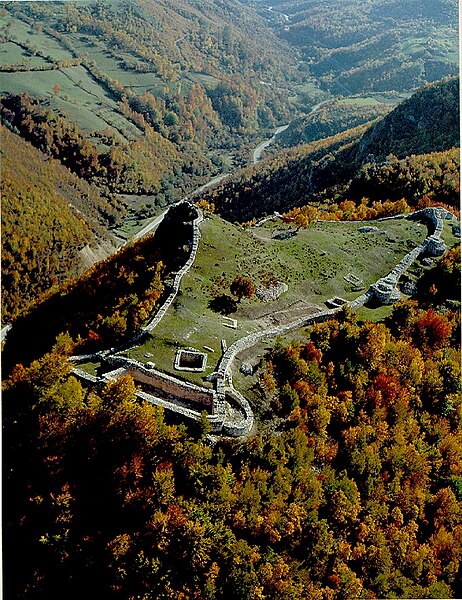Stefan Nemanja was the Grand Prince of the Serbian Grand Principality from 1166 to 1196. A member of the Vukanović dynasty, Nemanja founded the Nemanjić dynasty, and is remembered for his contributions to Serbian culture and history, founding what would evolve into the Serbian Empire, as well as the national church. According to the Serbian Academy of Sciences and Arts, Nemanja is also among the most remarkable Serbs for his literary contributions and altruistic attributes.
Donor's portrait of Stefan Nemanja, fresco in the Virgin's Church of the Studenica Monastery
Remains of the Church of the Holy Mother of God at the confluence of the Kosanica and the Toplica River. This is Nemanja's first endowment built in 1158–1162. Monastery was abandoned after the Great Migration of Serbs during the Great Viennese or Great Turkish War of 1688–1690.
Monastery of St. Nicholas at the confluence of the Banjska and the Toplica River near modern day Kuršumlija. This church represents Nemanja's second endowment, which was built around 1166 in the Byzantine style.[citation needed] It was built and painted by the best masters from Constantinople.
Remains of the cave monastery church of St. Archangel Michael on a cliff at the foot of Ras fortress. According to folk legend, Nemanja was imprisoned in this cave.
Grand Principality of Serbia
Grand Principality of Serbia, also known by anachronistic exonym as Rascia, was a medieval Serbian state that existed from the second half of the 11th century up until 1217, when it was transformed into the Kingdom of Serbia. After the Grand Principality of Serbia emerged it gradually expanded during the 12th century, encompassing various neighbouring regions, including territories of Raška, modern Montenegro, Herzegovina, and southern Dalmatia. It was founded by Grand Prince Vukan, who initially served as regional governor of the principality, appointed by King Constantine Bodin. During Byzantine-Serbian wars Vukan gained prominence and became a self-governing ruler in inner Serbian regions. He founded the Vukanović dynasty, which ruled the Grand Principality. Through diplomatic ties with the Kingdom of Hungary, Vukan's successors managed to retain their self-governance, while also recognizing the supreme overlordship of the Byzantine Empire, up to 1180. Grand Prince Stefan Nemanja (1166–1196) gained full independence and united almost all Serbian lands. His son, Grand Prince Stefan was crowned King of Serbia in 1217, while his younger son Saint Sava became the first Archbishop of Serbs, in 1219.

Europe in 1135
Remains of the medieval fortress or Ras, the capital of Serbian Grand Principality since mid-12th century; today UNESCO World Heritage Site
Medieval tombstones Stećci found in Grand Principality of Serbia; today UNESCO World Heritage Site
Grand Prince Stefan Nemanja, died in 1199 as monk Simeon








